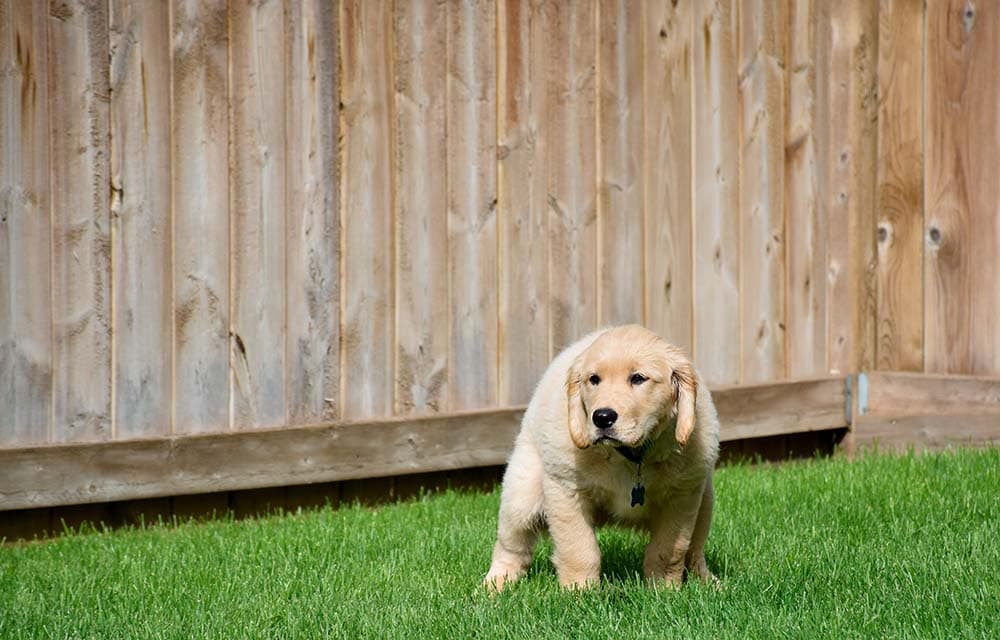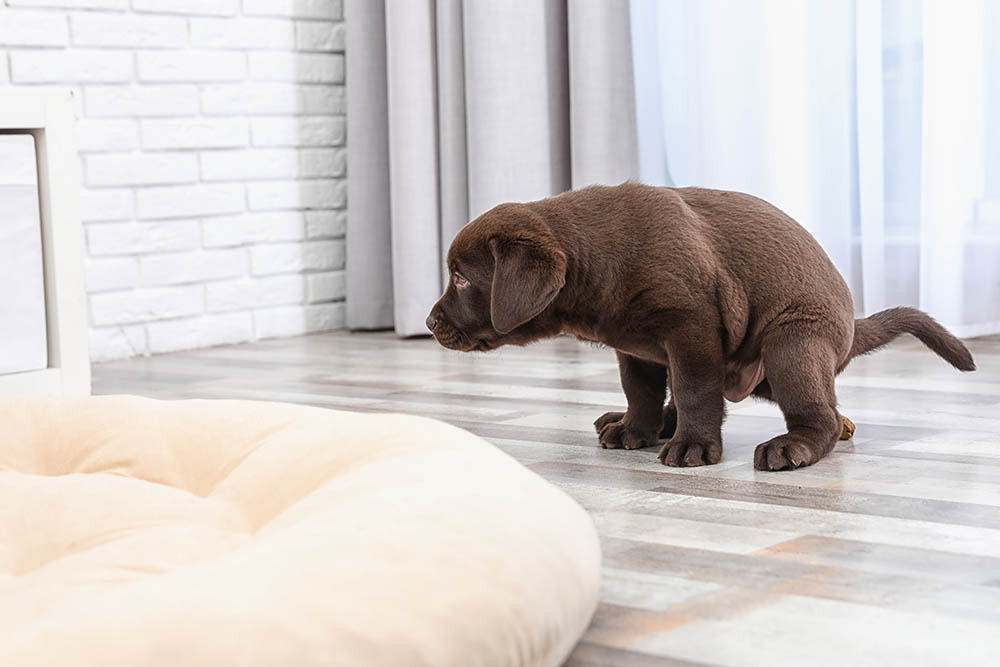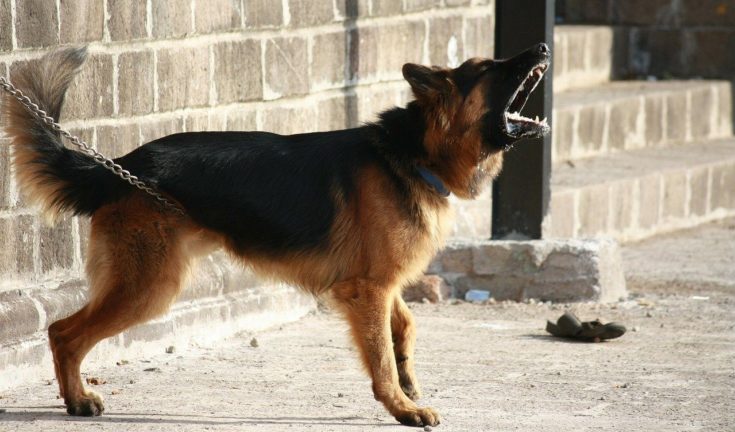Why Does My Puppy Poop So Much? Vet-Reviewed Health Facts & FAQ

Updated on

It is time to get your game face on for today’s topic. Although poo is never a pleasing conversation, when it comes to your puppy, it is more important than you think. As a matter of fact, your veterinarian uses your dog’s droppings as their main barometer to determine their overall health.
If you have a brand-new puppy, though, the number of bathroom trips can be alarming if you are not familiar with how much a puppy poops. To save you the suspense and worry, puppies are like babies—cute, cuddly, and always going!
That being said, there are some instances when you should be worried. In this article, we will go over how much is too much, what should be considered an emergency vet visit, and how you can reduce the overall number of bathroom breaks.
Why Does My Dog Poop So Much?
The average adult dog typically goes to the bathroom between one and three times per day. A puppy can go twice that amount. As a general rule, the younger the pooch, the more they are going to go.
The determining factor of poo volume is the amount of fiber in their diet. Other factors, such as their size, age, metabolism, and health, can also impact their toilet habits. For example, a change in diet, anxious situations, and a deviation of their normal routine can be at fault.
Overall, though, the concerning question regarding your dog’s poo goes beyond how much there is and includes the frequency and consistency. We know examining your puppy’s fecal matter is probably not on your bucket list, but it can help you figure out what is normal for your pooch and what is cause for alarm.
In general, you want to be aware of consistency, frequency, color, size, and make-up. (Gross but necessary, we know.) Once you have an idea of what a normal poop looks like for your pup, your only job is to make sure it stays consistent. Loose, watery, or off-color waste is when you want to be worried, which we will go over in more detail further on.

Why Is My Puppy Pooping a Lot Lately?
Many new pup parents tend to get alarmed when their furball starts to go more frequently. If they have been paying attention to consistency and started to notice a pattern, then an increase can seem like a problem
Determining the reason for the increase is usually a simple matter of deduction. Here are the most common reasons for an increase in potty runs:
- Too Much Food: Overfeeding your puppy can result in more frequent bathroom trips. It is interesting to know how many puppy parents are shocked by this revelation. In general, fur babies should be fed three to four times per day. If you are giving them five small meals, you can combine them into three meals a day. Conversely, if you are doing only two meals a day, this can be too much food at once, and you should even it out to avoid other tummy issues.
- Leftovers: Yes, we are sure you have heard this before, but table scraps are not good for your pet. Human food has ingredients that dogs have a hard time tolerating. Greasy foods, sugar, and other ingredients can have a very lucrative effect on your furball’s bowels—if you catch our drift. In short, skip the leftovers and find healthy treats instead.
- Change: We touched on this briefly before, but a change in diet or environment can cause more bathroom breaks. Diet specifically can give your ankle biter’s stomach a shock. New scenery can cause your pet excitement and stress, which can also affect their digestive system.
Again, as long as your puppy is showing the same consistency, an increase of pooping frequency in 1 day or so should not be a worry, especially if you can pinpoint one of the factors above as the cause.
What Is Not Normal?
Unfortunately, other underlying issues could be affecting your puppy’s poop schedule. You want to be aware of the warning signs so you can take the right steps to correct it. Let’s take a look at the different circumstances that would be a cause for concern:
- Diarrhea: A change in consistency and increased frequency of feces is the definition of diarrhea. Any poo that is loose or watery is a sign of gastrointestinal distress. The cause can be several factors, including diet, eating table scraps, or anxiety. In some cases, though, it can be more serious. You should also watch out for vomiting. Try to give your pooch a bland diet and lots of water, and monitor them for improvement. If they do not, you should seek help from a professional.
- Deviation From Their Normal Routine: If your furball has created a poo space (which all dogs do), and they start going in other areas, that can be a sign of trouble. This is especially true if they also show other signs of issues.
- Blood: If you notice blood in your puppy’s stool, you need to get them to the veterinarian immediately. From the deadly parvovirus to worms, blood in the feces needs to be investigated by a vet.
- Color: You should know the normal color of your dog’s poop. If you notice dark or black coloring, this could indicate digested blood. A red color also means bleeding, but it’s closer to the anus and not digested. Yellow or orange poop usually indicates an issue with the liver, while white or gray poop points to a problem with the pancreas or gallbladder. Any of these colors could be cause for concern, though certain things that get ingested can also affect poop coloration.
- Mucus or Grease: While oily or fatty food can make poop look greasy, this could also indicate pancreatic issues. Mucus could point toward parasites or intestinal inflammation. If all your puppy’s feces look this way, get them checked by the vet right away.
- Worms: To spare you the gory details, here is a concise explanation. You will notice worms in your dog’s poop due to the contrast of white on brown. Rice or sesame seed-like particles are a good example. If you see these, go to the vet.
- Food: If your puppy is on a fresh food diet, it is perfectly normal to see a bit of undigested plant material. The same principle applies if they ate some grass. However, seeing undigested kibble is an indication that there likely is a problem that needs to be addressed.
Overall, these are the most common poo problems. Although we mentioned an increase is not necessarily an issue if consistency is okay, the opposite is not true. If you notice your pup has not gone to the bathroom in more than 2 days, you should call your vet. Also, keep a lookout for whining, grass eating, and glances at their tummy region, along with an overall lethargic attitude.
- How to dispose of dog poo – Click here!

Can I Reduce the Poop?
As your puppy grows, the frequency that they need to go poo will gradually be reduced. It is normal for young puppies to poop six times in a day, which makes sense because their feedings are also more frequent. Potty training will help prevent in-home accidents, especially as your puppy will gradually reduce the number of times a day that they need to poo.
Take a look at these proven methods to successfully potty train your puppy.
- Create a schedule: Try to form a consistent schedule with your pooch so they will become accustomed to potty time. The best time to take them is right after a meal, first thing in the morning, the last thing before bed, after nap time, and after playtime.
- Positive Reinforcement: It is important to reward your pooch when they go at the scheduled time in the correct place. Throw your pooch a treat for good poo etiquette.
- Gradually Decrease Their Meals: As your puppy grows, you should be able to gradually decrease your pup’s feedings from four to five times a day to three. This will also cut down on the number of bathroom breaks that they need. Additionally, try to find food that has less fiber.
- Potty Spot: This goes back to routine, but bringing your pooch to the same spot every time will reinforce training and help them recognize when it is time to go.
- Key Words: Use the same words or phrases to indicate bathroom time, like “potty” or “bathroom.” Try to avoid these words until it is time to go. Your pup picks up on more subtle clues than you would think, and they can often associate “potty time” with going outside or for a walk.
Conclusion
The moral of the poo story is that too much is probably normal. As long as you are keeping an eye on the “matter” itself, you will soon come to see what is concerning and what is not. We hope this article has relieved your stress and given you the information you need to go back to enjoying time with your fur baby.
Also See:
- How to Make Your Dog Poop Quickly (6 Effective Tips)
- 5 Reasons Dog Rolls in Poop (and How to Stop It)
Featured Image Credit: JulieK2, Shutterstock












